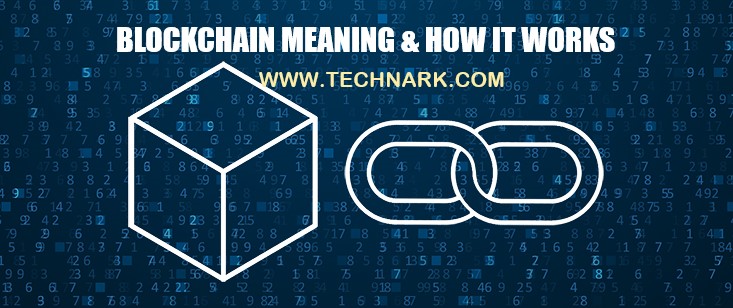If you are a Blockchain user, you will understand the fact that it has continued to grow and increasingly becoming more user-friendly. Hence, it is important to know more about its evolving technology, to keep you ready and up-to-date for the future.
In recent years, a lot of people have been hearing about blockchain technology, especially concerning cryptocurrency like bitcoin. The term may seem like a platitude, but in a hypothetical point of view, given that there’s hardly any real meaning that a layman can easily understand. However, this article will help you to understand what Blockchain is all about and how it works.
What Is the Meaning of Blockchain?

Also known as Distributed Ledger Technology (DLT), Blockchain has to do with record-keeping technology created to enable the hacking of the system or forging of data stored on it, which makes it secure and immutable. Blockchain is historically a digital asset unalterable and transparent thanks to the use of decentralized networks and cryptographic hashing.
As long as blockchain technology is concerned, it is a decentralized, distributed ledger, which enables the storage of ownership records of digital assets. Once data is saved on blockchain, it can hardly be modified, which makes the technology a legitimate disruptor for industries such as payments, cybersecurity, and healthcare.
Invented in 2008 by Satoshi Nakamoto, a Japanese tech pro, the blockchain was designed to serve as the public transaction ledger of the cryptocurrency bitcoin to record transactions and related data in multiple places at the same time. Hence, making the first digital currency that solves the double-spending issue without a trusted authority or central server.
Again, the blockchain technology is a distributed database, which keeps an increasingly growing list of ordered records, otherwise known as blocks, which are linked using cryptography. However, a single block has a cryptographic hash of the former block, a timestamp, and transaction data. Some proponents of blockchain are developing and testing other uses.
What are the Types of Blockchain?
As earlier discussed, the blockchain technology is a shared, immutable ledger, facilitating the process through which transactions are recorded, and helps to track assets in a business network. These assets can be tangible or intangible, and can be tracked on a blockchain network; thus reducing risk and cutting costs. But there are several kinds of blockchain.
- Private Blockchain Networks
This type of blockchain network works on closed networks, and often functions better for private businesses and organizations, which is why it is called private blockchain networks. Firms can adopt private blockchain type to customize their accessibility and authorization preferences, parameters to the network, and other essential security options. Meanwhile, only a single authority runs this blockchain type.
- Public Blockchain Networks
Unlike the private blockchain, this type plays a crucial role in originating bitcoin and cryptocurrencies. Apart from that, the public blockchain networks also help to popularize distributed ledger technology (DLT). It can also get rid of certain challenges or problems like security flaws and centralization.
DLT enables data distribution across a peer-to-peer network, instead of storing it in one location. It uses a consensus algorithm to verify the authenticity of information, and the two most frequently used are the proof of stake (POS), and proof of work (POW) methods.
- Permissioned Blockchain Networks
Some people call it hybrid blockchains, the permissioned blockchain networks are a kind of private blockchains, which grants special usage to authorized individuals. They are typically designed by organizations to enable them to get the best of both worlds. It also helps to bring about better structure when assigning those that can partake in the network and in what transactions.
- Hybrid Blockchains
The hybrid blockchain is another common type of blockchain, which is a combination of both public and the private types of blockchains. In other words, some components of this blockchain are public and transparent, whereas the others are private and can only be accessed by authorized and certain participants.
The hybrid blockchain is best for use in situations that demand a balance between transparency and privacy. For instance, it can access certain information that concerns supply chain management for multiple parties. On the other hand, it can keep sensitive data private.
- Consortium Blockchains
This type of blockchain works almost like permissioned blockchains, as it contains both public and private parts, aside from the fact that multiple organizations tend to run a single consortium blockchain network. Even though this category of blockchain can initially be more complicated in terms of its set up, immediately they start to run, better security is assured. Again, they are best for collaboration with multiple organizations.
- Blockchain Layers
This type of blockchain has to do with the building of several layers of blockchains on one another. Each of the layers comes with its consensus mechanism, rules, and functionality that can interact with other layers. In these situations, it promotes greater scalability, because transactions can be processed in parallel across different layers.
For instance, the Lightning Network that is built on top of the Bitcoin blockchain is a second layer solution to ensure faster and cheaper transactions by establishing payment mediums between users.
- Sidechains
As long as side chains are concerned, they operate in sync to the main blockchain, which allows for extra functionality and scalability. This type allows developers to experiment with recent contents and applications without affecting the main blockchain’s integrity.
For instance, you can use side chains to establish decentralized applications and to implement specific consensus mechanisms. You can also use them to carry out transactions of the main blockchain to reduce congestion and increase scalability.
How Does Blockchain work?
Generally, the blockchain is a digital database made up of encrypted blocks of data, combined and secured by complex math problems. These math problems that involve nonces and hashes are very difficult for subsequent changes, as the record of initial actions on the blockchain is highly accurate and safe from manipulation.
Again, the blockchain is shared identically across various decentralized nodes, which ensure no organization can own or manipulate it. Meanwhile, while underlying blockchains mechanisms are complex, we have provided a brief overview in the steps below. Blockchain software can automate the following steps:
Step 1: Record the Transaction
Thanks to the blockchain transaction, you can see the movement of physical or digital assets from one party to another in the blockchain network. It is stored as a data block and can contain details like the following:
- Who was involved in the transaction?
- What happened during the transaction?
- When did the transaction occur?
- Where did the transaction occur?
- Why did the transaction occur?
- How much of the asset was exchanged?
- How many pre-conditions were met during the transaction?
Step 2: Gain Consensus
There are certain users on the distributed blockchain network that must accept the fact that the recorded transaction is valid. Based on the type of network, rules of agreement may vary but are significantly created at the beginning of the network.
Step 3: Connect the Blocks
After reaching a consensus, participants are to write transactions on the blockchain into blocks equivalent to the pages of a ledger book. A cryptographic hash is also attached to the new block together with the transactions.
Meanwhile, the hash serves as a chain that connects the blocks together. If what the block contains is intentionally or unintentionally modified, the hash value will change, and thus it will provide a means of detecting data tampering. Hence, the blocks and chains connect securely, and cannot be edited.
Each extra block strengthens the verification of the initial block and hence, the whole blockchain. This process could be likened to the stacking of wooden blocks to create a tower. You can only stack blocks on top, and once the block is removed from the middle of the tower, the entire tower breaks.
Step 4: Share the Ledger
The final step has to do with the distribution of the ledger. Here, the system shares the latest copy of the central ledger to every participant.
What Does Decentralization in Blockchain Mean?

Decentralization is one of the most significant concepts as long as blockchain technology is concerned. No computer or organization is allowed to own the chain, as it requires the distribution of ledger through the nodes attached to the chain.
Blockchain enables the data in a database to be distributed among many network nodes at different locations, especially the computers or devices that run software for the blockchain. This operation helps to establish redundancy and maintain the fidelity of the data.
For instance, if a person attempts to alter a record, at one instance of the database, the other nodes would stop it from taking place. By doing so, it prevents any single node within the network from altering information held within it. This distribution will enable the information and history such as the transactions in cryptocurrency to become irreversible.
Such a record could be a list of transactions like with a cryptocurrency, but it is also possible for a blockchain to store a lot of different information such as legal contracts, state identifications, or even an inventory of a company.
Benefits of Blockchain

There are lots of benefits that come with using blockchain technology, and the main one is that it is a database for recording transactions. Again, another thing you cannot escape is that it removes the possibility of tampering by a malicious actor. Check out the most common benefits of blockchain below:
-
-
Time-Saving: Blockchain reduces the time needed for transactions from days to just minutes. Settling transactions is faster, as it doesn’t need verification by a central authority.
-
Saving Costs: Transactions require minimal oversight. As a participant, you can be involved in the direct exchanging of items of value. Blockchain also gets rid of duplication of effort, as participants have the right to a shared ledger.
-
Stronger Security: Blockchain security features protect against tampering, fraud, and cybercrime. It is a primary benefit of this technology, as it enables every blockchain transaction to be cryptographically secure and provide integrity. Hence, rather than depend on third-party, you can trust cryptographic algorithms.
-
Immutability Benefits: As long as the traditional database is concerned, you can trust a system administrator that he cannot alter the data. But thanks to blockchain, there’s no way data can be changed or altered, as the stored data is permanent. In other words, you can neither delete nor undo it.
-
Transparency: Unlike the centralized systems that are not transparent, the blockchain, which is a decentralized technology, provides complete transparency. Through the use of blockchain technology, organizations and companies can opt for a total decentralized network where a centralized authority is not needed. Hence, it helps to improve the transparency of the whole system.
-
High Availability: Blockchain is not like the centralized systems; therefore, it is a diffused system of P2P network that is highly available because of its decentralized state. Here, given that everyone is on a P2P network and has a running computer in the blockchain, and everyone, it means that even if one peer goes down, the other peers will still function.
-
Conclusion
Blockchain is a peer-to-peer decentralized distributed ledger technology, which ensures the records of any digital asset is transparent and immutable and runs without any need for third-party intermediary. It is an emerging and revolutionary system that has increasingly attracted much public attention, thanks to its ability to minimize risks and fraud in a scalable way.
Blockchain technology has become so popular and beneficial that over 90% of U.S. and European financial institutions have started considering its use. In fact, this system comes with several benefits just as we discussed above. Meanwhile, you can feel free to share your thoughts in the comment section below.
